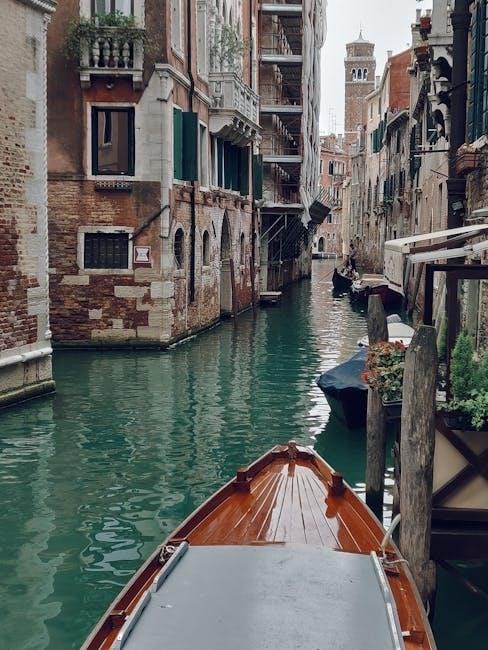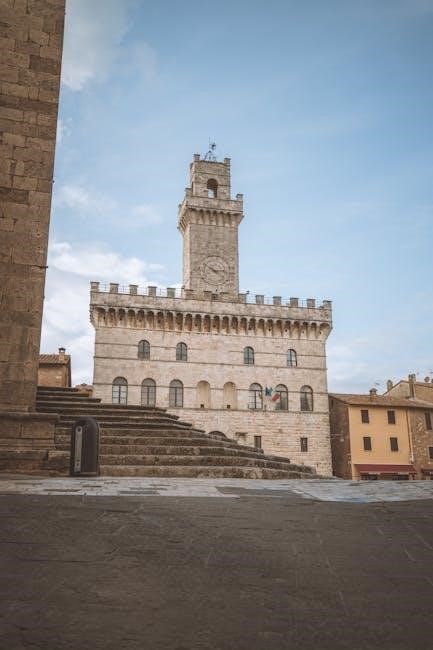Discover essential Italian travel phrases with our printable PDF guide. Learn must-know expressions for greetings, directions, food, and emergencies. Perfect for your Italian adventure!
Why Learning Italian Phrases is Essential for Travelers
Learning Italian phrases is crucial for travelers to navigate Italy with confidence. While many Italians speak English, knowing basic phrases enhances your experience, showing respect for the culture. Simple greetings like “Ciao” or “Buongiorno” can lead to warmer interactions. Essential phrases for asking directions, ordering food, and handling emergencies are vital for independence. A printable PDF guide provides quick access to key expressions, ensuring you’re prepared for any situation. Mastering Italian phrases not only simplifies travel but also deepens your connection with the locals and their way of life. Start with basics like “Per favore” (please) and “Grazie” (thank you) to make your journey smoother and more enjoyable.
Essential Italian Phrases for Travel
Mastery of essential Italian phrases ensures smooth navigation of Italy. From greetings to directions, these expressions empower travelers to communicate confidently and immerse themselves in the culture.
Mastering common Italian greetings is the first step to connecting with locals. Start with Ciao (Hello/Goodbye), Buongiorno (Good morning), Buona sera (Good evening), and Buona notte (Good night). Introduce yourself with Mi chiamo (My name is) or Sono di (I am from). Express pleasure with Piacere (Nice to meet you) and Piacere mio (The pleasure is mine). Use Per favore (Please) and Grazie (Thank you) for politeness. Don’t forget Scusa (Excuse me) and Mi dispiace (Sorry). Ask Come ti chiami? (What’s your name?) or Come stai? (How are you?) to engage in conversations. These phrases are essential for making a good first impression in Italy.
Asking for Directions and Information
When navigating Italy, knowing how to ask for directions is crucial. Start with Scusi, posso chiederle un’informazione? (Excuse me, can I ask for some information?) or Sa indicarmi la strada per…? (Can you show me the way to…?). Use Dove posso trovare..;? (Where can I find;..) for locations like restrooms, pharmacies, or train stations. Ask Quanto costa? (How much does it cost?) for prices or Come si chiama questo posto? (What is this place called?) for names. For repetition, say Potrebbe ripetere, per favore? (Could you repeat, please?) or Parli più piano, per favore? (Speak more slowly, please?). These phrases will help you confidently seek assistance and navigate Italy with ease. Mastering them ensures a smoother travel experience.
Numbers and Counting in Italian
Mastering numbers in Italian is essential for tasks like shopping, telling time, and understanding prices. Start with the basics: uno (one), due (two), tre (three), quattro (four), cinque (five), sei (six), sette (seven), otto (eight), nove (nine), and dieci (ten). For higher numbers, learn undici (eleven), dodici (twelve), and venti (twenty). Use quaranta (forty), cinquanta (fifty), and cento (hundred) for larger quantities. Phrases like Quanto costa? (How much does it cost?) and Il conto, per favore (The bill, please) are invaluable. Practice counting aloud to build confidence. This will help you navigate everyday situations like purchasing tickets or asking for prices during your Italian travels.
Ordering Food and Drinks
Learning how to order food and drinks in Italian enhances your dining experience. Start with greetings like “Ciao!” (Hello!) or “Buongiorno!” (Good morning!). Ask for the menu with “Il menu, per favore” (The menu, please). Common phrases include “Vorrei un caffè, per favore” (I would like a coffee, please) and “Un bicchiere di vino rosso, per favore” (A glass of red wine, please). For food, try “La pasta al pomodoro, per favore” (Tomato pasta, please) or “Il pizza margherita, per favore” (Margherita pizza, please). Don’t forget “Il conto, per favore” (The bill, please) and “Tutto molto buono, grazie” (Everything was very good, thank you). Practice these phrases to confidently enjoy Italy’s culinary delights!
Emergency and Useful Phrases
Knowing emergency and useful phrases in Italian is crucial for a safe and smooth trip. Start with “Aiuto!” (Help!) or “Policia” (Police) for urgent situations. Ask for directions with “Dov’è l’ospedale?” (Where is the hospital?) or “Dov’è la farmacia?” (Where is the pharmacy?). For assistance, say “Posso avere aiuto, per favore?” (Can I have help, please?). Useful phrases include “Non parlo italiano” (I don’t speak Italian) and “Mi dispiace, non ho capito” (Sorry, I didn’t understand). For emergencies, dial 112, the European emergency number. Learn these phrases to stay prepared and communicate effectively during your travels in Italy.
How to Practice Italian Phrases Effectively

Master Italian phrases by practicing daily with flashcards, language apps, and podcasts. Engage in conversations with native speakers to build confidence and improve pronunciation effortlessly.
Using Flashcards for Memorization
Flashcards are a simple yet effective tool for memorizing Italian travel phrases. Create cards with the Italian phrase on one side and the English translation on the other. Review them daily, focusing on pronunciation and meaning. For phrases like “Scusi, posso chiederle un’informazione?” (Excuse me, can I ask you something?), write the phrase and its translation. Use the printable PDF guide to find pre-made flashcards or create your own. Practice regularly, especially before trips, to build confidence in using the phrases. This method helps reinforce memory and ensures quick recall when needed during your travels.

Listening to Italian Podcasts and Radio
Listening to Italian podcasts and radio is an excellent way to immerse yourself in the language. Tune into popular Italian travel podcasts that focus on phrases for travelers. Shows often include conversations, pronunciation tips, and cultural insights. Radio stations like Rai Radio or Radio Italia offer a variety of programs that can help you get accustomed to native speech. Pay attention to common phrases like “Dove posso trovare un bagno?” (Where can I find a restroom?) or “Quanto costa questo?” (How much does this cost?). This method not only improves your listening skills but also helps you pick up natural expressions and intonation. Many podcasts are available for free and can be paired with your printable PDF guide for a comprehensive learning experience.
Practicing with a Native Speaker
Practicing with a native Italian speaker is one of the most effective ways to improve your language skills. Conversing with someone who speaks Italian fluently helps you refine your pronunciation, understand regional accents, and learn natural expressions. Use platforms like Tandem or HelloTalk to connect with native speakers. Discuss topics like travel, food, and culture while using phrases from your printable PDF guide. This interaction will build your confidence and prepare you for real-life conversations in Italy. Remember, natives appreciate your effort to communicate, so don’t hesitate to ask for clarification or repeat phrases. This hands-on practice will make your Italian travel phrases feel more natural and authentic.

Cultural Tips for Communicating in Italy
Understanding Italian culture enhances communication. Use gestures and body language to emphasize points. Formal greetings like “Buongiorno” are appreciated. Respect formal language with elders. Italians value effort in speaking their language.
Understanding Italian Gestures and Body Language
Italian communication is deeply rooted in gestures and body language, which often complement verbal expressions. A wave of the hand can mean “I don’t know,” while tapping your forehead may signal “I remember.” Italians use expansive gestures to emphasize emotions, making conversations lively and expressive. Understanding these non-verbal cues can enhance your interactions. For instance, a gentle touch on the arm can convey friendship, while raised eyebrows may express surprise. Mastering these gestures can help you communicate more effectively and connect authentically with locals. Practice mimicking these expressions to blend in and show respect for the culture. It’s a fun way to enrich your Italian travel experience!
Formal vs. Informal Language Usage
Understanding the difference between formal and informal language is crucial in Italy. Formal Italian, or italiano formale, is used with strangers, elders, or professionals, while informal language is reserved for friends and family. For example, “Lei” is the formal “you,” whereas “tu” is informal. Phrases like “Per favore” (please) and “Grazie” (thank you) are used in both contexts, but their delivery may vary. Mastering formal language shows respect, especially in professional or traditional settings. Informal language, however, helps build rapport with locals. Knowing when to use each ensures clear communication and cultural appropriateness during your travels. It’s a key aspect of blending in and making a positive impression in Italy.

Downloading and Using the Printable PDF Guide
Download our free printable PDF guide featuring 125 essential Italian travel phrases. Perfect for easy access, it includes translations, pronunciation, and key expressions to enhance your Italian adventure.
Benefits of a Printable Italian Phrase Guide
A printable Italian phrase guide offers convenience and accessibility for travelers. It provides a compact, easy-to-carry resource with essential phrases for various situations, from greetings to emergencies. The guide includes English translations, Italian phrases, and pronunciation tips, making it ideal for quick reference. Offline access ensures you can navigate Italy without relying on internet connectivity. Organized categories, such as food, directions, and shopping, help you find phrases instantly. This guide also fosters cultural connection by helping you communicate respectfully and effectively. Whether you’re exploring Rome, Venice, or Milan, a printable guide is a invaluable tool for a seamless and enjoyable Italian adventure.